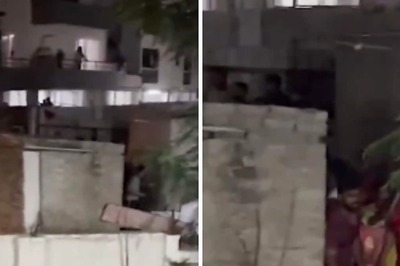
views
Islamabad: A group of highly-trained militants with night-vision goggles and the collusion of sympathetic Islamist military officials storm a heavily-guarded navy base situated only a few miles from where a unstable Pakistan stores some of its nuclear weapons.
That is the scary way of looking at the attack on the navy base in Karachi on Sunday night that destroyed two U.S.-built aircraft and killed 10 military personnel, fuelling worries about the safety of the world's fastest-growing nuclear arsenal.
The consensus remains that Pakistan's 70-100 nuclear weapons are safe. Security at installations is reportedly much higher. It is almost impossible for a rogue team to launch any missiles and the vetting of staff at these bases is extremely rigorous.
But each attack in Pakistan seems to up the ante, surprising analysts and military alike about how far militants can reach into the heart of the powerful military establishment -- perhaps one day doing enough to steal nuclear material for a "dirty" bomb or successfully penetrating a nuclear facility.
In Sunday's attack, attackers scaled walls with ladders to enter PNS Mehran, one of Pakistan's most heavily guarded bases, and held off the military for nearly 17 hours.
"It reinforces the fear that terrorists have now developed a range of tactics - foreknowledge, use of uniforms, simultaneous attacks on different entry points, etc - which enable them to penetrate high-security bases and, crucially, hold space within them for hours," Professor Shaun Gregory, director of the Pakistan Security Research Unit at Bradford University, wrote in an email.
"This is a blueprint for an attack on a nuclear facility."
The attack took place only 15 miles (24 km) away from a suspected Pakistan nuclear weapons storage site at Masroor air base, a sign of how close the nuclear arsenal is to the growing violence from the Pakistan Taliban and other militant groups.
Even in some of Pakistan's more nationalistic media, which for years has dismissed criticism of the safety of the nuclear arsenal as foreign-inspired propaganda, doubts have surfaced.
"This easy action by the terrorists has rightly raised concerns among the nation that neither any part of the country nor our nuclear installations are safe," Urdu newspaper Nawa-i-Waqt said in its editorial on Tuesday.
Some commentators said it was possible that the attack could only have happened with help of insiders within the base - perhaps disaffected and low-level military personnel angry at increasingly open U.S. operations on its soil.
The fear is these kind of insiders could assist an assault on a nuclear base. Even an unsuccessful attack could sow panic in the military and spark more pressure from Washington.
The Taliban hinted at local help, but remained coy to whether there were inside the base.
"Our 'local friends' from Karachi helped us in yesterday's operation but I would not say whether we had friends on the base or not," Taliban spokesman Ehsanullah Ehsan told Reuters from an undisclosed location.
ONLY THE LATEST SETBACK
The attack comes after the killing of Osama bin Laden by U.S. forces sparked suspicion the al Qaeda leader may have been helped for years by sympathisers within Pakistan's intelligence services.
Nor was this the first attack at the heart of Pakistan's military. There was an attack at the army general headquarters in Rawalpindi in 2009. Later investigations found low ranking soldiers and officers were involved in planning the attacks.
U.S. diplomatic cables from 2006 published in local media showed then Deputy Chief of Air Staff for Operations, Air Vice Marshal Khalid Chaudhry as reporting of small scale sabotage from low ranking Islamist officials to stop aircraft being deployed in security operations along the Afghan border.
This all may lead to a nightmare scenario for the West of a small group of officials managing to steal nuclear material, load it up with conventional explosives, and set it off.
"(The) major concern is not having an Islamic militant steal an entire weapon but rather the chance someone working in government of Pakistan facilities could gradually smuggle enough material out to eventually make a weapon," U.S. ambassador to Pakistan Anne Patterson said in a 2009 cable released by WikiLeaks, according to media reports.
U.S. officials have said that they do not know everything about the size and location of Pakistan's nuclear arsenal, but have publicly voiced confidence in Pakistan's ability to secure its weapons.
There are some 10,000 soldiers guarding the facilities and only 5 percent of individuals pass strict screening tests for staff at the facilities, according to a report by Shashank Joshi of the U.K.-based Royal United Services Institute think-tank.
Experts say nuclear weapons are stored separately from delivery systems - meaning any militants ability to launch weapons is almost impossible.
But analysts point to weakness in the system.
"Separate storage may provide a layer of protection against accidental launch or prevent theft of an assembled weapon, it may be easier for unauthorized people to remove a weapon's fissile material core if it is not assembled," The U.S. Congressional Research Service said in a report in January.
There are also concerns that any future stand-off with nuclear foe India could lead to a chaotic situation with nuclear weapons dispersed around the country, straining Pakistan's military command structure.
Pakistan's move to develop short range tactical nuclear weapons may also make them more vulnerable to theft or a mutiny by a group of military officers.
"If they are designed for battlefield use, they could present an easier target for terrorists to seize and use themselves," wrote Ben Rhode, research associate for non-proliferation and disarmament at The International Institute for Strategic Studies, in an email to Reuters.




















Comments
0 comment